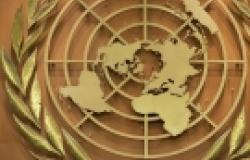The UN through the Pop-Culture Looking Glass

Pablo Castillo Diaz explores the United Nation's portrayal in popular culture.
Conduct the following exercise: scroll through a list of actors who have played the role of the U.S. President, whether fictional or real, in films or on television. You will find that the most comprehensive lists have close to 1,000 actors (including about twenty actresses). Now do the same for representations of the highest official of the United Nations, the Secretary-General. Your search will yield at most a handful of names, and a majority of them are unknown actors in relatively obscure movies, and often without a single line in the script.
This stark contrast points to a broader phenomenon related to the place of the United Nations in global popular culture, and particularly Western mass media. At 70 years of age, spanning the best decades of cinema and television, the most famous, iconic, and telegenic international organization in the world barely registers in the history of either the big or the small screen, and when it does the results are markedly unflattering.
There is no major movie where the Secretary-General is one of the main characters. Seven decades and more than seventy peace operations later, there is no big production where the UN’s “blue helmets” are the protagonists of the story. There have been multiple, though so far unsuccessful, attempts to make a television series featuring the United Nations, from recent aspirations to replicate the success of The West Wing (1999–2006) back to the 1960s when the biggest names in the entertainment business came together to produce a series of TV movies about the UN. In fact, this push was a reaction to failed presidential candidate and US Ambassador to the UN Adlai Stevenson being assaulted by anti-UN protesters in Dallas, one month before John F. Kennedy’s fatal visit to that city in 1963. However, the project was quickly thrown into obscurity due to the apparent disinterest of (American) audiences.
Part of the explanation may be lack of access. For example, both Alfred Hitchcock in 1957 and Sacha Baron Cohen in 2010 were denied access to UN premises to shoot on location. However, this did not prevent either from making the UN a part of both North by Northwest and The Dictator, and for all its faults the UN is far from being a hermetic or secretive organization.
There are two more plausible explanations. The first one has to do with the perennial antipathy towards this organization by a significant share of the American public across the political spectrum – from paranoid suspicion among conservatives to general disappointment by liberals. As an illustration, one of the most famous Hollywood movies about the UN, The Interpreter (2005), featuring Sean Penn and Nicole Kidman, ended up removing the UN flag from its poster to not offend the US public and showed the American flag prominently instead.
The iconic blue helmets make surprisingly few appearances in movies, frequently as a context element, such as in movies like last year’s Beasts of No Nation (2015) about civil wars and child soldiers in West Africa or In the Land of Blood and Honey (2011) about the Balkans, directed by Angelina Jolie, a UN Special Envoy herself. When UN peace operations are more central to the storyline, they are more villains than heroes, from The Whistleblower (2010) about sex trafficking in the Balkans to Hotel Rwanda (2004), which depicts what may be the organization’s most shameful failure to prevent or even mitigate a genocide.
The two pop culture phenomena most revered by American liberals since 1999, the above-mentioned The West Wing, and the fake news comedy shows The Daily Show (1999- ) and The Colbert Report (2005-14) (formerly headlined by Jon Stewart and Stephen Colbert respectively), feature the UN extensively, but generally not in a positive light. In The West Wing, the only conversation between President Bartlet and the UN Secretary-General is through the phone, a short outburst in which the US President screams at the Secretary-General about diplomats not paying parking tickets in New York City and hangs up on him before letting him speak. Two different plotlines show clever dialogue about the diplomatic maneuvering needed to secure Security Council resolutions favourable to the White House’s interests for peacekeeping in the Middle East and sanctions against Sudan, but they focus on the importance of cynical horse-trading rather than principled positions for votes, and on ridiculing the ability of a particular country (in this case, Turkmenistan) to hold these negotiations hostage as the rotating president of the Council. Similarly, although Stewart and Colbert often mocked conservative attacks on the UN, from UN climate reports to treaties on disability and on the global arms trade, the main theme of these segments is resigned disappointment about the UN’s impotence (“an impotent bureaucracy rooted in pointless formality” or “the world’s most powerful, completely impotent organization”), as well as derision about the yearly antics and eccentricities of world leaders at the General Assembly in Manhattan every September. Tellingly, the tone is much different when addressing the work of UN development or humanitarian agencies in the field, such as John Oliver’s segments on UNESCO or John Stewart’s interview of the head of UNHCR in Jordan, in charge of the largest camps hosting Syrian refugees.
But things are not very different outside the United States. The most extensive –and arguably best- treatment of the UN’s diplomatic squabbles come from a British movie, In The Loop (2009), and a French movie, The French Minister (2013), both comic reinterpretations of each government’s position in the UN vis-à-vis the invasion of Iraq. And yet neither can resist mocking the UN, both the building (“It could do with a few more scatter cushions and a bit less asbestos” or “it looks like a hospice for robots”) and the organization’s significance and relevance (“This is a sacred space. You may not believe that, I may not believe that, but by God it’s a useful hypocrisy” and “All that energy for a speech no one will listen to”).
A second explanation may be related to the inherent difficulty of grasping or understanding what the UN actually does or can do, something that surely contributes to the most common–and positive–representations of the UN on television or in cinema being inaccurate or completely fictional ones for dramatic effect, as shown by Brad Pitt’s portrayal of a former staffer of the UN’s World Health Organization in World War Z (2013), or the covert espionage agency of the UN in The Art of War (2000), in which Wesley Snipes cracks heads for world peace. An organization like the UN -but under different names- gains in prominence in futuristic works, from Star Trek to Star Wars to the Batman TV series or the Marvel Comics universe. Aptly, the UN appears at times in movies or TV as our way of making first contact with aliens, such as in The Day The Earth Stood Still (1951) or in the popular Reagan-era TV miniseries V (1983-85), in which aliens land one of their ships on the roof of the UN headquarters in New York.
In the end, this may be more about the subject matter itself. The UN is not one thing, but many, and even insiders need years to understand the multi-layered nature of the UN in all its manifestations. It generally operates under strict parameters of consent and consensus that do not translate well in a script or the screen, and the inner workings of diplomacy and bureaucracy are rarely the stuff toward which either audiences or storytellers gravitate. For all these reasons, making a popular cultural product about the UN for a mass audience that is both compelling and realistic is a daunting task, but it is surely one worth the effort.
This post first appeared on E-International Relations.
Image by United States Mission Geneva


